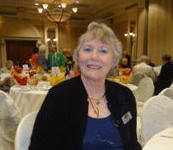Member Musings features the reflections and thoughts of an NPC member.
I WAS FINE UNTIL I SAW THE MEALWORMS
You might think I would cringe at the prospect of cleaning a bald eagle’s flight cage—with the male eagle perched in the corner, eyeing me with some kind of sinister bird-of-prey calculation. Didn’t bother me in the least. I bailed out his pool, brushed away accumulated algae forming a “bathtub ring,” refilled the pool from the garden hose I carried in from the aisle between cages, then disposed of his uneaten food. Two rats, a mouse and a mullet. Guess he wasn’t hungry that day. As part of my routine, I entered the leftover food items in the log for the staff to ponder. After a couple of other small chores—hosing off the “dining log” and raking the ground on my way out—I moved on to the next cage.
This was my introduction to training as a volunteer at The Conservancy’s Wildlife Rehabilitation Hospital. I did all of the tasks above with instruction and demonstration by my trainer Steve.
In the second flight cage, two large owls pretended nonchalance, but I know they never took their eyes off me while I followed the same procedure in their cage. Bail out the pool, get rid of the algae, refill the pool, rake the ground, wash off the small log on which the night staff had placed their food, remove and record uneaten items. The owls left little for me to remove.
I reminded myself that, after all, this is a hospital. All these birds had some kind of deficiency that kept them from being returned to the wild. Perhaps the eagle didn’t eat much because he’s sick and has no appetite. Maybe I’d learn more about the patients from the hospital staff.
The final outside area for me to learn about in my first day of training was the water bird pool. Here, pelicans and cormorants generally make a mess of things. Lots of waste to hose off and only a few uneaten morsels to document. I did observe a distressing sight: a cormorant in the water was being attacked by a pelican. I alerted Steve, who scooted right over to investigate. He pried the cormorant out of the pelican’s beak. It was dead. He removed it from the water and left it in the corner of the cage.
After we disposed of all the uneaten morsels we’d collected that morning and stripped off our vinyl gloves, we reported the dead cormorant to the staff member in the inside bird room. She rushed to the pool to retrieve the body for the staff veterinarian to determine cause of death. “We’ve had this bird only a week, and we didn’t know it was that sick,” she said as she breezed past Steve and me with the towel-wrapped corpse.
Steve was so efficient in his training that I still had an hour and a half on my four-hour commitment. So I followed around some of the trained volunteers in the bird room. One woman showed me where to find the various types of foods the staff might ask me to retrieve from the massive refrigerators—rats, mice, large mullet, tiny mullet—and, on a shelf outside the fridge, a drawer full of mealworms. “We always have to pull out the dead ones before we scoop a handful for one of the patients,” she said.
I can handle dead rodents and fish, but my tummy went atilt when I saw the wriggling mass of tiny worms.
Really?


